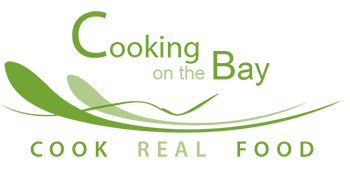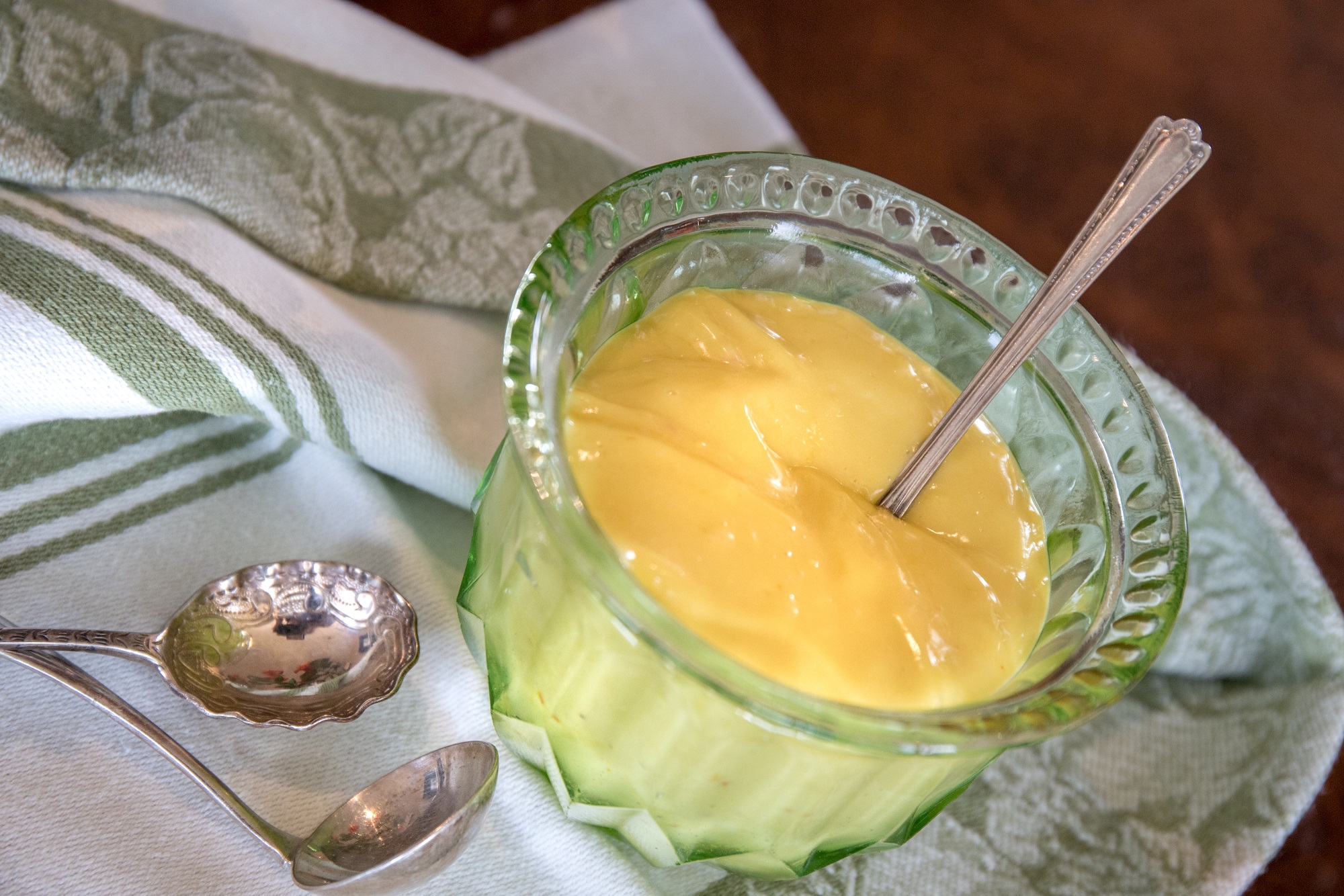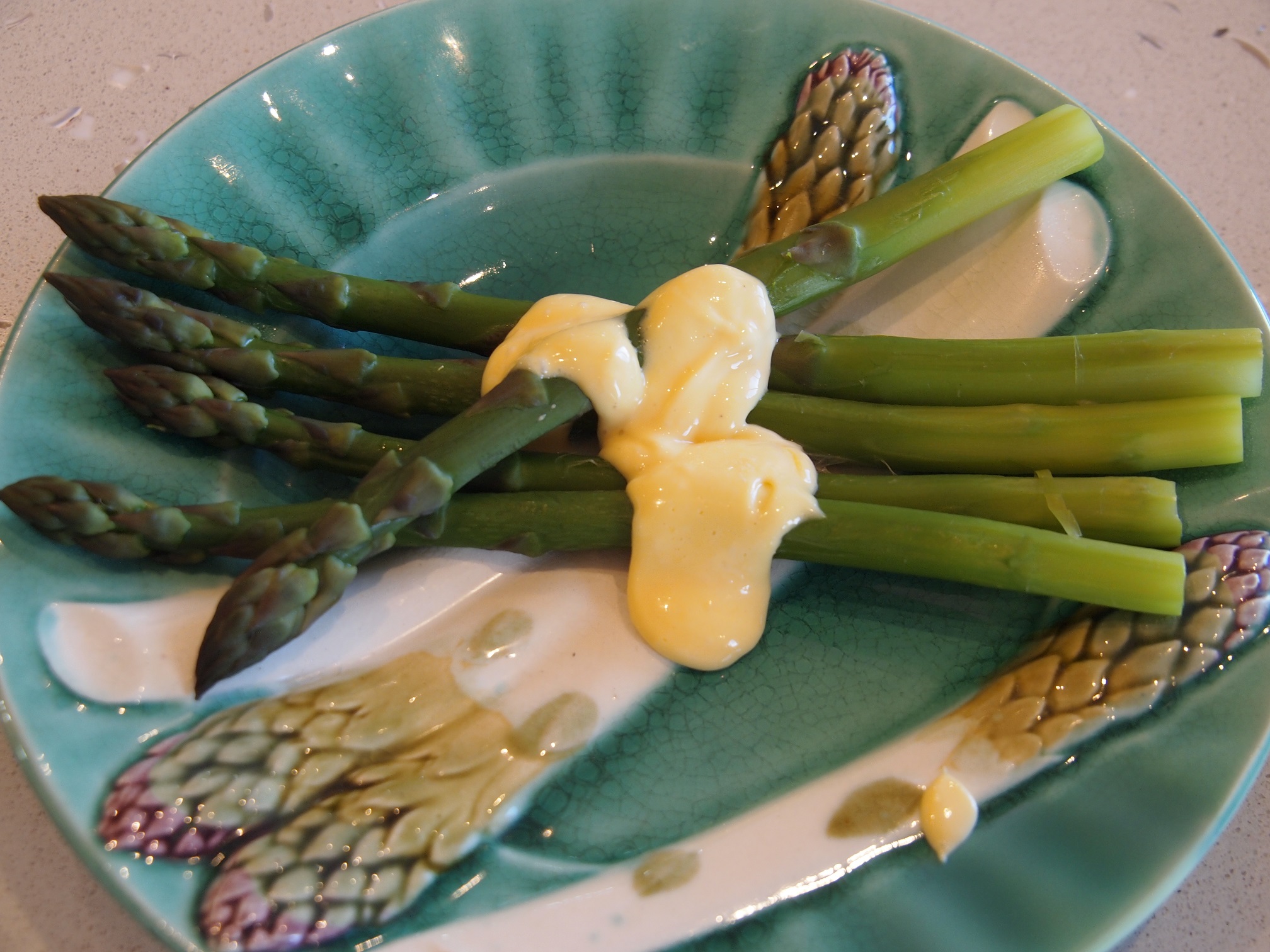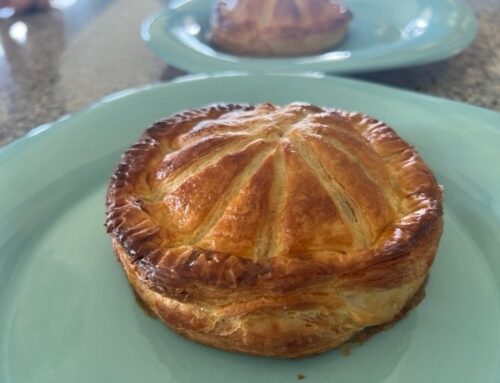Hollandaise sauce is a classic emulsion* sauce, made with egg yolks and butter, seasoned with lemon juice, salt and a little white pepper to become a thick, yellow, creamy sauce. It is the traditional partner to asparagus, artichokes, and eggs Benedict. It is perfectly matched with poached fish and vegetables. I love it drizzled over our Salmon en Croûte.
Here you will find my two methods, the classic method, making it by hand and the other using the machine, with either the hand wand or the vitamiser.
Classic Hollandaise made by hand
Anne Willan from La Varenne Cooking School, in Paris and Burgundy, believes that the most reliable way to make a hollandaise is to make a mousse by whisking the egg yolks water, one tablespoon per yolk, over direct heat, or using a double boiler. It is best made directly on the stove as the double boiler is a very tedious method. This process will take at least 3 minutes. The mousse helps to stabilise the sauce, so that melted butter can be added without the sauce separating.
A heavy-bottomed pan is important for making hollandaise so the heat is evenly distributed and the eggs cook to a close-textured mousse. Do not use a cast iron pan, as it holds its heat too well and you risk curdling the eggs.
Serves 4 making about 250g of sauce.
175g butter, clarified
45ml water
3 egg yolks
Sea salt and white pepper
Juice of ½ lemon, about 20ml or to taste
To clarify the butter: melt the butter over low heat, without stirring, for about 5 minutes, until foaming. Leave to stand for a minute or two to allow the milk solids to settle on the bottom. The fat on the top is clear butterfat or ghee. Pour it carefully through a wet piece of muslin into the jug. All the froth and milk solids will be caught in the cloth, resulting in crystal-clear liquid butter or ghee underneath. Set aside and let it cool to tepid. The melted butter must be warm, not hot, and roughly about 37°C.
To make the Hollandaise sauce: in a small, heavy-based saucepan, whisk the water and egg yolks with a little salt and pepper for 30 seconds until thoroughly combined and light in colour. Set the pan over low heat and whisk constantly, for about 3 minutes, or until the mixture is creamy and thick enough for the whisk to leave a trail for 5 seconds on the base of the pan, as for a sabayon. The base of the pan should never be more than hand-hot or the eggs will scramble. The eggs’ temperature should be about 37°C, roughly the same as the butter.
Remove the pot from the heat and whisk in the tepid butter, a few drops at a time. Do not add the butter too fast or the sauce may curdle. When the sauce has started to thicken, the butter can be added a little faster. The slow addition of the butter and the thickness of the egg mixture are the two factors that control the thickness of the sauce.
When all the butter is added stir in the lemon juice and taste for seasoning, adding salt, pepper, and more lemon juice to taste. The consistency of hollandaise should be light enough to pour easily from a spoon. If it is too thick, add more lemon juice or water.
Hollandaise is served warm, not hot, and should be kept warm in a water bath to avoid curdling. Some cooks like to keep the sauce warm in a thermos.
* An emulsion is a mixture of two or more ‘unblendable’ liquids. These 3 are emulsion sauces: Hollandaise is bound with butter, and flavoured with lemon juice; Bearnaise is bound with butter and flavoured with vinegar, eschallots and tarragon. Mayonnaise is flavoured with lemon juice and bound with olive oil.
Hollandaise used using the machine
Serves 4 making about 250g of sauce.
150g butter
3 egg yolks
20ml water
20ml lemon juice
Sea salt and white pepper to taste, plus some extra lemon juice
Combine egg yolks, lemon juice, and water in a container suitable for use with the stick blender, or in a vitamiser. Grind in two turns of white pepper and add a tiny pinch of salt. Blend together well. the better you blend at this stage, the easier it is to have success when adding the butter.
Roughly cube the butter and place it into a saucepan; gently melt the butter until foaming or bubbling, but not turning brown. Watch carefully, ensuring it does not brown at all.
With the blender still running, add the hot butter, drop by drop to start with, slowly increasing the amount of hot butter as it is incorporated into the egg mixture. Continue to slowly add the melted butter, omitting the milky residue at the bottom of the pot. You are really using clarified butter or ghee to make this sauce. Taste and adjust the seasonings, adding more salt, pepper or a few extra drops of lemon juice if necessary.
The amount of butter you can use when making this sauce in a blender is only half the amount the egg yolks could absorb if you were making the sauce by hand, when 3 egg yolks can take up to 250g of butter. If you added more butter to the vitamiser than the 150g, the sauce would become too thick.
So, to double your amount of sauce, pour it out of the container into a bowl or saucepan and beat into it an additional 125g of melted butter, added very slowly.
If your Hollandaise sauce refuses to thicken, pour it out into another container, and then pour it back into the liquidising container. Continue to blend whilst adding the mixture drop by drop. As the butter cools, it begins to cream and forms into a thick sauce.
If the sauce curdles or separates, slowly add a tablespoon of cold water, drop by drop, blending continuously.
* An emulsion is a mixture of two or more unblendable liquids, such as Vinaigrette, mayonnaise, hollandaise and bearnaise sauce.
Hints on how to rectify a curdled sauce, a sauce that will not thicken or one that is too thick
From Anne Willan, founder and chef of La Varenne École de Cuisine, Paris and Burgundy.
I like Anne Willan’s hints and have used the second hint, once in class when the sauce curdled. We do not usually curdle the sauce! When teaching my students how to make these emulsion sauces, such as a Hollandaise and Mayonnaise, I always remind the class that the 10 minutes spent slowly adding the butter and oil respectively, is better than starting the whole process all over again. Take it slowly and enjoy the process.
- If the sauce curdles, remove from the heat; to re-emulsify, the sauce, add an ice cube and whisk briskly to gradually draw in the curdled sauce
- If unsuccessful with method one, start again. Add 2 egg yolks to your clean bowl with 30ml water and whisk briskly with some salt and pepper for 30 seconds until thoroughly combined and light in colour. Place the pot over low heat and slowly add the curdled egg mixture as you do for the hollandaise making above. It should thoroughly emulsify and be a creamy hollandaise sauce.
And hints from Julia Child’s ‘Mastering the Art of French Cooking.
- If the sauce refuses to thicken: if you have beaten in the butter too quickly, and the sauce refuses to thicken, rinse out a mixing bowl with hot water, put in a teaspoon of lemon juice, and a tablespoon of the sauce. Beat with a wire whisk for a moment until the sauce creams and thickens. Then, beat in the rest of the sauce a dessertspoon at a time, beating until each addition has thickened in the sauce, before adding the next.
- If the sauce curdles or separates: beat in a tablespoon of cold water; if this does not fix it, use the method above.
- If the sauce is too thick: beat in 1 to 2 tablespoons of warm water, lemon juice, or stock.
The heating and the thickening of the egg yolks: so that the egg yolks will thicken into a smooth cream, they must be heated slowly and gradually. Too sudden heat will make them granular and overcooking will scramble them. You may beat them over hot water or low heat; it makes no difference as long as the process is slow and gentle.
The butter: egg yolks will readily absorb a certain quantity of butter when it is added to them gradually, giving them time to incorporate each addition before another is presented. When too much butter is added at a time, particularly at first, the sauce will refuse to thicken. If the amount of butter is more than the yolks can handle, the sauce will curdle. About 90g of butter is the usual maximum amount per egg yolk. For those who have not made a Hollandaise before, it is safer to go with 60g per yolk.
- Spanish Aliöli – garlic and saffron mayonnase









